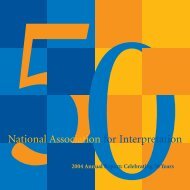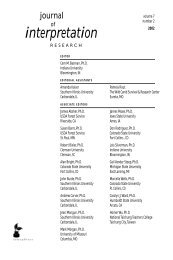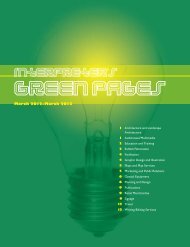interpretation
Volume 15, Number 1 - National Association for Interpretation
Volume 15, Number 1 - National Association for Interpretation
Create successful ePaper yourself
Turn your PDF publications into a flip-book with our unique Google optimized e-Paper software.
o l i v i a b u c k<br />
the permanent galleries is considerably lower, usually under four minutes for a whole<br />
gallery. Fewer visitors are prepared to follow the narrative of the gallery. Instead 70%<br />
of visitors “browse” the gallery, stopping at two or three objects, at which point they<br />
may engage and look closely at the object and read its associated label. Less than 10% of<br />
visitors read the panels which provide vital contextual information about the objects.<br />
In response to these findings we have made some changes in our new galleries that<br />
we believe will help visitors engage more deeply with the objects and at the same time<br />
deliver more key messages:<br />
Panels<br />
Evaluation showed that while few visitors read gallery or subject panels in galleries,<br />
they do nevertheless expect them in a display. Visitors are drawn to objects rather than<br />
panels. The strength of panels seems to be the sense of visual and intellectual structure<br />
that they give. For this reason we retained panels but used them more as signage with<br />
limited word counts.<br />
Gateway objects<br />
These are carefully selected objects throughout<br />
recently redisplayed galleries that act as “gateways”<br />
to a particular section or theme. The Japan gallery<br />
is a good example of this new technique. The aim is<br />
that visitors will engage with these gateway objects<br />
and the texts immediately next to them and then<br />
be drawn to other nearby objects. Through careful<br />
positioning, display, lighting, images and text we have<br />
tried to make the gateway objects attractive to visitors,<br />
enticing them to engage. This is a direct response to<br />
our research showing that visitors read more labels The retired townsman statue<br />
than panels in permanent galleries. We have placed<br />
some essential contextual information with the objects to encourage visitors to read more.<br />
The results are heartening, the dwell time in the Japan gallery is around 11 minutes, and<br />
visitors on average stop at 12 gateway objects (27% of the objects in the gallery), which is<br />
significantly higher than most other galleries.<br />
Evaluation<br />
We undertake different forms of evaluation in order to have a better understanding of<br />
visitors’ interests and needs.<br />
Terminology Testing<br />
We use terminology testing and personal meaning maps to get a good sense of what<br />
visitors understand by certain key terms. This means that when drafting interpretive<br />
text we know what preconceptions visitors have about certain words. We have also<br />
carried out formative evaluation on potential gateway objects. This gives us a valuable<br />
insight into what type of questions visitors ask about an object and we can endeavor to<br />
answer them in the label texts.<br />
© t h e tr u s t e e s of th e br i t i s h mu s e u m<br />
46 j o u r n a l o f i n t e r p r e t a t i o n r e s e a r c h












